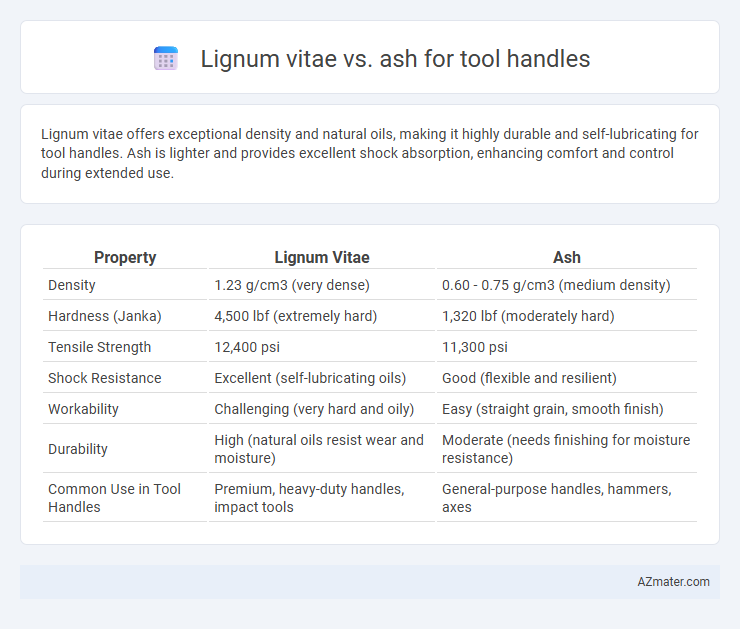Lignum vitae offers exceptional density and natural oils, making it highly durable and self-lubricating for tool handles. Ash is lighter and provides excellent shock absorption, enhancing comfort and control during extended use.
Table of Comparison
| Property | Lignum Vitae | Ash |
|---|---|---|
| Density | 1.23 g/cm3 (very dense) | 0.60 - 0.75 g/cm3 (medium density) |
| Hardness (Janka) | 4,500 lbf (extremely hard) | 1,320 lbf (moderately hard) |
| Tensile Strength | 12,400 psi | 11,300 psi |
| Shock Resistance | Excellent (self-lubricating oils) | Good (flexible and resilient) |
| Workability | Challenging (very hard and oily) | Easy (straight grain, smooth finish) |
| Durability | High (natural oils resist wear and moisture) | Moderate (needs finishing for moisture resistance) |
| Common Use in Tool Handles | Premium, heavy-duty handles, impact tools | General-purpose handles, hammers, axes |
Introduction to Lignum Vitae and Ash Wood
Lignum vitae, known for its exceptional hardness and natural oils, provides unmatched durability and resistance to wear, making it an ideal choice for heavy-duty tool handles. Ash wood offers a lightweight yet strong alternative with impressive shock resistance and a straight grain that enhances grip and minimizes vibration. Both species excel in tool handle applications, with lignum vitae favored for longevity and ash prized for flexibility and comfort.
Key Characteristics of Lignum Vitae
Lignum vitae is renowned for its exceptional density, hardness, and natural oil content, providing superior shock resistance and self-lubrication ideal for durable tool handles. Its high lignin content makes it incredibly resistant to wear, moisture, and decay compared to ash, which is lighter and less dense but offers good flexibility and ease of shaping. The natural oils in lignum vitae reduce maintenance needs, making it a premium choice for heavy-duty applications requiring longevity and strength.
Key Characteristics of Ash Wood
Ash wood is renowned for its exceptional strength-to-weight ratio, making it a preferred choice for tool handles requiring durability and shock resistance. Its straight grain and fine, even texture provide excellent grip and comfort during use, while its natural flexibility helps absorb impact without cracking. Compared to Lignum vitae, Ash is lighter and easier to work with, though it may be less dense and slightly less resistant to wear and moisture.
Durability and Strength Comparison
Lignum vitae, known for its exceptional density and natural oils, offers superior durability and resistance to wear compared to ash, making it ideal for heavy-duty tool handles. Ash wood, while lighter and more flexible, provides good shock absorption but lacks the hardness and longevity of lignum vitae under continuous stress. For applications requiring maximum strength and enduring performance, lignum vitae outperforms ash in maintaining structural integrity and resistance to impact.
Weight and Workability Differences
Lignum vitae is significantly denser and heavier than ash, with a specific gravity of around 1.23 compared to ash's 0.60 to 0.75, impacting the overall weight of tool handles. The hardness and oiliness of lignum vitae provide superior durability and resistance to wear, while ash's lighter weight and moderate hardness make it easier to shape and more comfortable for extended use. Workability differences mean lignum vitae requires specialized tools and skills due to its density, whereas ash offers better machinability and easier sanding for custom handles.
Shock Absorption and Comfort
Lignum vitae offers superior shock absorption due to its natural density and oil content, reducing vibrations and user fatigue during prolonged use. Ash, while lighter and more flexible, provides moderate comfort with good shock resistance but less damping compared to Lignum vitae. Tool handles made from Lignum vitae typically deliver enhanced comfort and durability in high-impact tasks.
Resistance to Moisture and Decay
Lignum vitae is highly prized for tool handles due to its exceptional resistance to moisture and natural decay, attributed to its dense, oily wood composition that repels water and inhibits fungal growth, making it ideal for outdoor and marine tools. Ash, while moderately durable and somewhat resistant to moisture, tends to absorb water more readily, leading to quicker degradation and reduced lifespan in wet environments. Choosing Lignum vitae over Ash significantly enhances tool handle durability in conditions with high exposure to moisture and decay factors.
Cost and Availability
Lignum vitae is significantly more expensive than ash due to its rarity and slow growth, making it less accessible for widespread tool handle production. Ash offers a cost-effective and readily available alternative, sourced abundantly from fast-growing hardwood trees native to North America and Europe. The affordability and widespread availability of ash make it the preferred choice for manufacturers prioritizing budget and supply consistency.
Common Uses in Tool Handles
Lignum vitae is prized in tool handles for its exceptional density, natural oils, and self-lubricating properties, making it ideal for heavy-duty tools like hammers and mallets due to its high durability and resistance to wear. Ash, known for its flexibility, shock absorption, and lightweight strength, is commonly used in handles for axes, baseball bats, and other tools that require both durability and ease of control. The choice between lignum vitae and ash depends on the specific tool application, balancing hardness and impact resistance against weight and flexibility requirements.
Conclusion: Which Wood is Better for Tool Handles?
Lignum vitae offers superior density, natural oil content, and exceptional durability, making it highly resistant to wear and moisture for tool handles. Ash provides a lighter weight, greater shock absorption, and easier workability, ideal for tools requiring comfort and control. For heavy-duty applications demanding longevity and moisture resistance, Lignum vitae is better, while Ash suits tasks needing lighter, more flexible tool handles.

Infographic: Lignum vitae vs Ash for Tool handle
 azmater.com
azmater.com